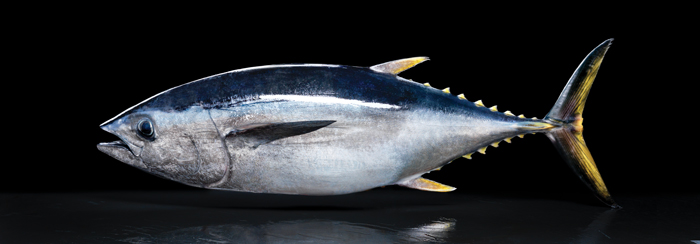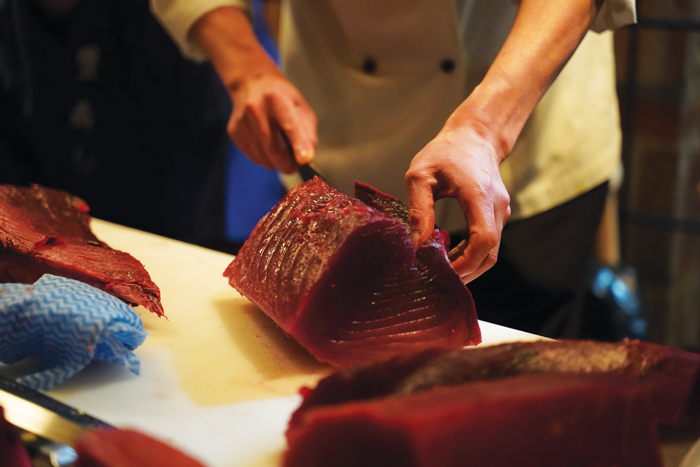Southern Bluefin Tuna is a premium fish, and it is backed by a good news story of species recovery, but bringing the best of the catch to market requires a concerted effort to meet highly focused quality requirements
By Catherine Norwood

The weather and the water are wild off the south-eastern coast of Tasmania; it is also where the Southern Bluefin Tuna (Thunnus maccoyii) (SBT) are in prime condition – fat and well fed on an abundance of small pelagic fish in local waters.
For skilled fishers, these tuna represent the chance to bring a premium wild product to discerning consumers, backed by a rich story of a species in recovery, good fisheries management and a fastidious level of care in the catch.
Their aim is to create a boutique Tasmanian-branded product that highlights both the story of the fish and the unique flavour and quality attributes of rod-and-reel-caught SBT from Tasmanian waters.
SBT are fished internationally from a single, global stock that is managed through the Commission for the Conservation of Southern Bluefin Tuna. Australia’s share of that stock is managed commercially by the Australian Fisheries Management Authority (AFMA) as a Commonwealth fishery. In 2020-21 Australia’s commercial quota is 5926.5 tonnes.
Most of this quota is held by fishers in South Australia, who purse seine the fish and tow them to inshore pens at Port Lincoln, where they are fattened in ranching operations that are more akin to aquaculture than wild-capture fisheries. There is also a growing SBT longline fishery off the NSW coast.
And for the past three years, a handful of fishers in Tasmania, with ‘minor line’ permits from AFMA, have leased some quota to try their hand with an SBT rod and reel troll fishery.
Among those championing Tasmania’s boutique SBT catch are rock lobster fisher Chris Hanson, boat owner Rocky Caccavo and international marketer Thomas de Kock, founder of TunaSolutions.
Based at Margate, south-east of Hobart, Chris Hanson says he has been “prospecting” for SBT for the past decade, working out where and when the fish are to be found. SBT numbers peak in Tasmanian waters in February, March and April, but he has found it is possible to catch SBT all year round – if you know where to look.
After finding the fish, catching them to optimise quality is the next challenge. In SA’s ranching operations, many of the variables around the catch and dispatch of the fish are undertaken quickly and in controlled conditions that make it easier to maintain a consistent quality.
On the open water, with a rod and reel, the conditions are less certain and more challenging for fishers targeting a premium product.
“There’s a particular skill required to catch fish on the troll and not everybody can do it,” says Thomas de Kock, whose family has long been involved in tuna fishing in South Africa, and rod and reel fishing in particular.
“If you slug the fish onto the boat as fast as you can, it will be full of adrenaline and lactic acid, it will be burnt and the meat will turn brown within a day. You’ll get maybe $3 or $4 a kilogram, which is an absolute waste for this fish.” He has been working with Tasmanian fishers to implement best practice in catch and handling processes.
‘Swimming’ the fish to the boat with an even effort is the primary tactic to prevent the adrenaline rush, and the fish are landed onboard onto mattresses. However, Chris Hanson says even then the results are not guaranteed, and factors that may have stressed the fish, such as predators nearby, are not always obvious.
The next phase of quality enhancement begins as soon as the fish is onboard and brain spiked. The three minutes between killing the fish and getting it into an ice slurry are critical to quality, explains Thomas de Kock.
“It’s the difference between getting $8 or $25 a kilogram for the fish,” he says, the higher price being the target of a premium Tasmanian wild-caught brand.
Businessman Rocky Caccavo committed one of his vessels to SBT and agrees it is a fishery that needs the right skippers, targeting the right fish, with a focus on quality. He says this may require some additional training for crew to meet the requirements of boutique buyers, such as high-end fishmongers and restaurants.

Tuna cutting exhibitions allow chefs to demonstrate how Southern Bluefin Tuna is dissected, while explaining every element of the fish and how the fish stock has rebounded with good management. Photo: TunaSolutions
The approach requires essentially fishing to order, rather than flooding the market with as many fish as can be caught. Buyers in Melbourne and Sydney have different size and fat requirements; the Japanese market wants something different again.
The result is that many fish hooked – sometimes more than half – are released before they are even brought onboard because they do not meet market requirements. Chris Hanson says the preferred size ranges from 30 to 60 kilogram fish; anything over 60 kilograms becomes increasingly difficult to transport as a whole fish.
“You have to have everything lined up, from the orders to the fishing, all the way to market; the logistics from Tasmania can definitely be a challenge.”
Thomas de Kock says the aim is to perfect the product–market fit and give buyers exactly what they want. “We’re also only taking from the water what we need for the market, offering a hand-selected product from a unique part of the ocean that provides a diverse diet for the fish, which is reflected in the flavour of their meat.”
One of TunaSolutions’ most successful marketing initiatives in 2019 and 2020 was a series of tuna cutting exhibitions with experienced chefs, which offered equal parts entertainment, education and culinary experience.
The continued development of this boutique fishery, whether targeting domestic or international markets, will rely on consistent supply, high-quality fish, reliable logistics and consumer demand. “To make it work you need fishers to really commit properly to quality and the buyers keen to support the product, and the fishery, year-round.”
Respect the catch
Australia provides five per cent of its total Southern Bluefin Tuna (SBT) quota for recreational fishing, and this catch is managed by the respective state jurisdiction. In 2020-21 this equates to 311.9 tonnes.
The FRDC helps to fund the Tuna Champions stewardship program, providing information for recreational fishers about the best practice handling and care of SBT. This includes the best equipment to use and techniques needed to give fish the best chance of survival if they are released.
Thomas de Kock of TunaSolutions has worked with Tuna Champions, sharing his knowledge about how to maintain the quality of the meat. FRDC-funded research has also played an important role in understanding and supporting the recovery of the international SBT stock from overfishing, promoting responsible fishing and respect for species at all levels.
More information
Chris Hansen, Tasmanian Wild Tuna, chris.taswildtuna@yahoo.com.au, @tasmanian_wild_tuna;
Thomas de Kock, TunaSolutions, thomas@tunasolutions.com, www.tunasolutions.com





